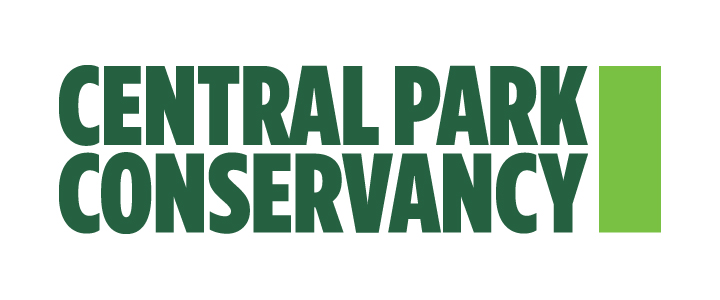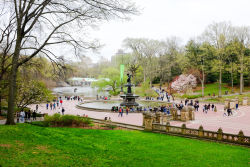Central Park
The Great Lawn
In the 1830s New York City was under tremendous pressure to develop a pure water system for its citizens. It was decided in 1838 to dam up the Croton River, 38 miles to the north of the city in Westchester as a source of clean water. Only the force of gravity was needed to run the water in open channels, iron pipes, and aqueducts to the great distributing reservoir at 42nd Street and Fifth Avenue. The 55-acre site here, a part of Yorkville, was chosen for the holding area-the rectangular-shaped receiving reservoir-and began use in 1842. Unlike the existing reservoir, there was no promenade or walkway surrounding the water's edge. A reservoir keeper lived in a dwelling on the site of the two northern ballfields. A portion of the reservoir wall can still be seen at the base of this sign.
When Frederick Law Olmsted and Calvert Vaux designed Central Park in 1858, they created thick plantings and earthen mounds to hide the high stone walls that they felt were unwelcome to their romantic landscape design. Nonetheless, they placed a miniature castle, called Belvedere (Italian for "beautiful view") atop Vista Rock in order to view the two reservoirs.
When New York City was incorporated in 1898 into today's five-borough metropolis, the existing water system was considered insufficient, and plans for a new water system rendered the old reservoir obsolete. Many proposals were generated, among them a water lagoon and a memorial to soldiers in World War I. The reservoir was filled in the 1930s, partially from excavation material for Rockefeller Center. Finally it was decided to use the area as a lawn and play area for children. The Beaux-Arts oval was designed by the New York Chapter of the American Society of Landscape Architects, who gave the Great Lawn its name. It was built with slight modification under the administration of Parks Commissioner Robert Moses and opened to the public in 1937. Baseball diamonds were added in the 1950s.
The small lake, originally designed as part of the Great Lawn and known as Belvedere Lake was renamed Turtle Pond by Parks Commissioner Stern in 1987 in honor of its reptilian residents. A nature blind has been added to the recent 1997 restoration of the pond so that park visitors might quietly observe the three species of turtles, dragonflies, and damselflies, and many varieties of waterfowl without disturbance.
The equestrian statue by Stanislaw Kazimierz Ostrowski on the eastern shore of Turtle Pond commemorates King Wladyslaw Jagiello, the first Christian Grand Duke of Lithuania who led Polish and Lithuanian forces against the Teutonic Knights of the Cross at the 1410 Battle of Grunewald. It was originally sited in front of the Polish pavilion at the 1939 World's Fair in Flushing Meadows Corona Park. The area in front of the statue has long been a gathering place for folk dancers.
In 1957 theater producer Joseph Papp offered free public performances of the works of William Shakespeare on the shores of the pond. Five years later the construction of the Delacorte Theatre was completed with funds provided by philanthropist George Delacorte. It is now the summer home of the Public Theatre/New York Shakepeare Festival. In the 1970s the Great Lawn became home to the free summer performances of the New York Philharmonic and the Metropolitan Opera.
Check out your park's Vital Signs
Clean & Safe
Green & Resilient
Empowered & Engaged Users
Share your feedback or learn more about how this park is part of a
Vital Park System
Contacts
Central Park Information: (212) 310-6600
Central Park Information (for the Hearing Impaired): (800) 281-5722
Belvedere Castle, The Henry Luce Nature Observatory: (212) 772-0210
The Charles A. Dana Discovery Center: (212) 860-1370
The Dairy Visitor Center and Gift Shop: (212) 794-6564
North Meadow Recreation Center: (212) 348-4867
Loeb Boathouse (Bike rentals, boat rentals & gondolas): (212) 517-2233
Carousel: (212) 879-0244
Fishing at Harlem Meer (Catch & Release): (212) 860-1370
Harlem Meer Performance Festival: (212) 860-1370
Horseback Riding - Claremont Stables: (212) 724-5100
Metropolitan Opera (Performances on the Great Lawn): (212) 362-6000
New York Philharmonic (Performances on the Great Lawn): (212) 875-5709
Shakespeare in the Park - The Public Theater at the Delacorte Theater: (212) 539-8655
Central Park SummerStage: (212) 360-2777
Swedish Cottage Marionette Theater: (212) 988-9093
Tennis: (212) 280-0205
Weddings, Ceremonies and Photography at the Conservatory Garden: (212) 360-2766
Wildlife Center & Tisch Children's Zoo: (212) 439-6500











